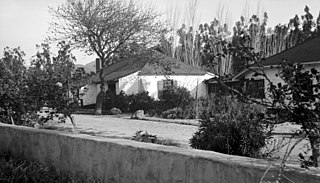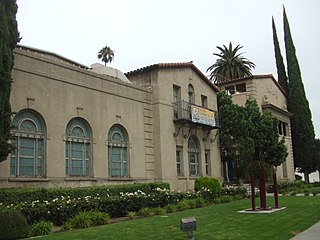
Riverside is a city in and the county seat of Riverside County, California, United States, in the Inland Empire metropolitan area. It is named for its location beside the Santa Ana River. It is the most populous city in the Inland Empire and in Riverside County, and is about 50 miles (80 km) southeast of downtown Los Angeles. It is also part of the Greater Los Angeles area. Riverside is the 59th-most-populous city in the United States and the 12th-most-populous city in California. As of the 2020 census, it had a population of 314,998. Along with San Bernardino, Riverside is a principal city in the nation's 13th-largest Metropolitan Statistical Area (MSA); the Riverside-San Bernardino-Ontario MSA ranks in population just below San Francisco (4,749,008) and above Detroit (4,392,041).

The Mission Inn, now known as The Mission Inn Hotel & Spa, is a historic landmark hotel in downtown Riverside, California. Although a composite of many architectural styles, it is generally considered the largest Mission Revival Style building in the United States. Mission Inn Hotel & Spa is a member of Historic Hotels of America, the official program of the National Trust for Historic Preservation.

The Bowers Museum is an art museum located in Santa Ana, California. The museum's permanent collection includes more than 100,000 objects, and features notable strengths in the areas of pre-Columbian Mesoamerica, Native American art, the art of Asia, Africa, and Oceania, and California plein-air painting. The Bowers organizes and hosts special exhibitions from institutions throughout the world, and travels exhibitions nationally and internationally. The museum has a second campus two blocks south of the main site, Kidseum, a children's museum with a focus on art and archaeology. The Bowers Museum and Kidseum are located in Santa Ana 6.4 km south of Disneyland.

Rancho Camulos, now known as Rancho Camulos Museum, is a ranch located in the Santa Clara River Valley 2.2 miles (3.5 km) east of Piru, California and just north of the Santa Clara River, in Ventura County, California. It was the home of Ygnacio del Valle, a Californio alcalde of the Pueblo de Los Angeles in the 19th century and later elected member of the California State Assembly. The ranch was known as the Home of Ramona because it was widely believed to have been the setting of the popular 1884 novel Ramona by Helen Hunt Jackson. The novel helped to raise awareness about the Californio lifestyle and romanticized "the mission and rancho era of California history."

The Louisiana State Museum (LSM), founded in New Orleans in 1906, is a statewide system of National Historic Landmarks and modern structures across Louisiana, housing thousands of artifacts and works of art reflecting Louisiana's legacy of historic events and cultural diversity.

The Indiana State Museum is a museum located in downtown Indianapolis, Indiana, United States. The museum houses exhibits on the science, art, culture, and history of Indiana from prehistoric times to the present day.

Sherman Indian High School (SIHS) is an off-reservation boarding high school for Native Americans. Originally opened in 1892 as the Perris Indian School, in Perris, California, the school was relocated to Riverside, California, in 1903, under the name Sherman Institute. When the school was accredited by the Western Association of Schools and Colleges in 1971, it became known as Sherman Indian High School.

Mount Rubidoux is a mountain just west of downtown in the city of Riverside, California, United States, that has been designated a city park and landmark. The mountain was once a popular Southern California tourist destination and is still the site of the oldest outdoor non-denominational Easter Sunrise service in the United States. Many historic markers and memorials have been placed on the mountain, the most prominent being the cross at the summit dedicated to Father Junípero Serra. A majority of Mt. Rubidoux is owned by the City of Riverside, while 0.43 acres at the peak is owned by Rivers & Lands Conservancy after the cross attracted a potential lawsuit and the city decided to sell it at auction it to a private organization.

Riverside Art Museum is an art museum in the historic Mission Inn District of Riverside, California. The museum is a non-profit organization which focuses on addressing social issues and offers art classes as well as other events in order to inspire and build community.

The Harada House is a historic house in Riverside, California. The house was the focus of a critical application of the California Alien Land Law of 1913, which prevented foreigners who were ineligible for citizenship from owning property. The state of California attempted to seize the property from the family in California v. Harada, but the Haradas ultimately won the case and retained ownership of the house. The house, created in 1884 and built upon by the Harada family, was declared a National Historic Landmark in 1990 and is currently overseen by the Museum of Riverside.

The New Jersey State Museum is located at 195-205 West State Street in Trenton, in the U.S. state of New Jersey. The museum's collections include natural history specimens, archaeological and ethnographic artifacts, and cultural history and fine art objects. Exhibitions, educational activities, research programs, and lectures are also offered. The museum, a division of the New Jersey Department of State, includes a 140-seat planetarium and a 384-seat auditorium.

The Orcutt Ranch Horticulture Center, formally known as Rancho Sombra del Roble, is a Los Angeles Historic-Cultural Monument located in the West Hills section of Los Angeles, California, USA.

Riverside, California, was founded in 1870, and named for its location beside the Santa Ana River. It became the county seat when Riverside County, California, was established in 1893.

Cabot's Pueblo Museum is an American historic house museum located in Desert Hot Springs, California, and built by Cabot Yerxa, an early pioneer of the Colorado Desert. A large, Hopi-style pueblo, built in the Pueblo Revival Style, it contains artworks, artifacts of American Indian and Alaska Native cultures, and memorabilia of early desert homesteader life. The museum may also be referred to as Cabot's Old Indian Pueblo Museum, Cabot's Trading Post or Yerxa's Discovery.

Sacramento History Museum is the only museum devoted to Sacramento, California and California Gold Rush history. It is located at 101 I Street in Old Sacramento. Just west of the museum is the Sacramento River and both the Tower Bridge and the I Street Bridge are visible from the museum.

The Colorado Springs Pioneers Museum is located at 215 S. Tejon Street in Colorado Springs, Colorado. The granite building with a domed clock tower was the El Paso County Courthouse building from 1903 to 1973. The museum, which moved to this location in 1979, has fine arts, artifacts and archival collections that document the Pikes Peak region. The building is on the National Register of Historic Places, and was the 2nd property to be listed in El Paso County, after Pikes Peak.

Newland House is an 1898 farmhouse in a midwestern adaptation of a Queen Anne architectural style in Huntington Beach, California, listed on the National Register of Historic Places. It is one of 123 historic places and districts on the National Register of Historic Places in Orange County, California. The Newland House is listed as the ninth historic place to receive a historical plaque from the Orange County Historical Commission in cooperation with the Orange County Board of Supervisors. The house has been identified as the site of the Tongva village of Lupukngna.

The Corona Founders Monument is a monument built in 1936 to the founding fathers of the City of Corona in the Riverside County, California. The monument was designated a California Historic Landmark (No.738) on June 6, 1960. The monument is in the Corona City Park in the 100 block of 6th Street of Corona, California. The founding fathers at first called the city South Riverside after the company they started the South Riverside Land and Water Company.
The Fort Walton Beach Heritage Park & Cultural Center is located on U.S. Highway 98 in the center of historic Fort Walton Beach, Florida. This archaeological site features multiple museums that showcase local history from 14,000 BCE through the 1950s. The cultural exhibits and landscape tell the story of 12,000 years of human occupation. Admission for all museums in the complex is taken at the Indian Temple Mound Museum building. Other museums and attractions on-site include the Indian Temple Mound Museum, Camp Walton Schoolhouse Museum, Garnier Post Office Museum, Civil War Exhibits Building, and Fort Walton Mound. All museums are located in close proximity to the base of the Fort Walton Mound.

The Peter J. Weber House is a historic house and landmark in Riverside, California. The house was designed and built by architect Peter J. Weber in the 1930s as a family residence and conceptual showcase of his creative work. The house is notable for its eclectic Depression-era design and its reliance on salvaged materials.



















